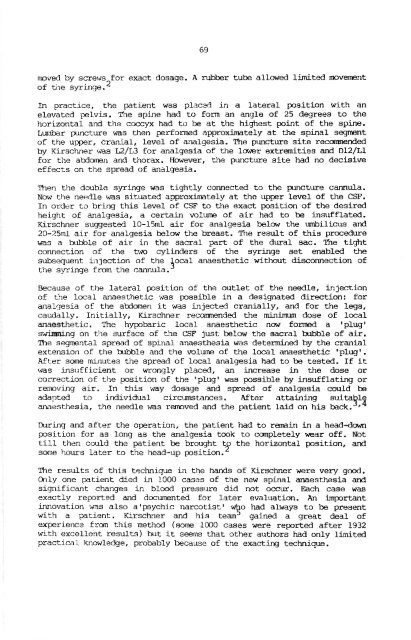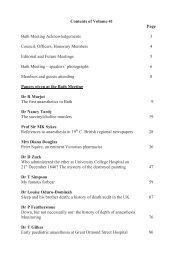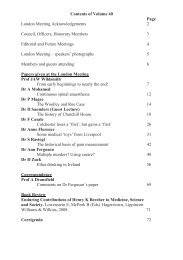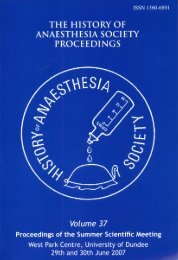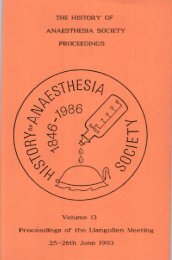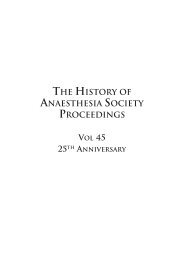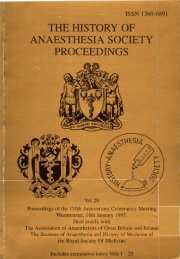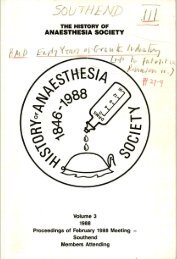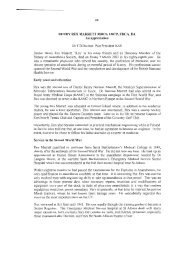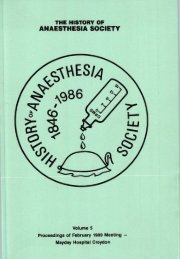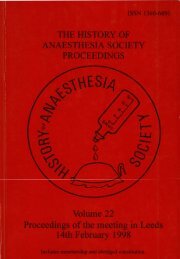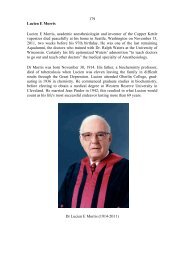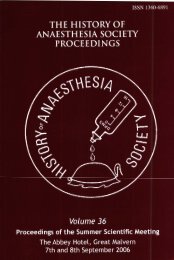Volume 9b - History of Anaesthesia Society
Volume 9b - History of Anaesthesia Society
Volume 9b - History of Anaesthesia Society
Create successful ePaper yourself
Turn your PDF publications into a flip-book with our unique Google optimized e-Paper software.
mved by screws for exact dosage. A rubber tube allowed limited movement<br />
<strong>of</strong> t"e syringe -2<br />
In practice, the patient was placd in a lateral position with an<br />
elevated pelvis. The spine had to form an angle <strong>of</strong> 25 degrees to the<br />
horizontal and the coccyx had to be at the highest point <strong>of</strong> the spine.<br />
Lwnbar puncture was then performed approximately at the spinal segment<br />
<strong>of</strong> the upper, cranial, level <strong>of</strong> analgesia. The puncture site recamended<br />
by Kirschner was L2/L3 for analgesia <strong>of</strong> the lower extrenities and D12/L1<br />
for the atdomen and thorax. However, the puncture site had no decisive<br />
effects on the spread <strong>of</strong> analgesia.<br />
Then the double syringe was tightly connected to the pmcture cannula.<br />
Now the needle was situated approximately at the upper level <strong>of</strong> the CS'.<br />
In order to bring this level <strong>of</strong> C S to the exact position <strong>of</strong> the desired<br />
height <strong>of</strong> analgesia, a certain ~lwre <strong>of</strong> air had to be insufflated.<br />
Kirschner suggested 10-15ml air for analgesia below the umbilicus and<br />
20-25m1 air for analgesia below the breast. The result <strong>of</strong> this procedure<br />
was a bubble <strong>of</strong> air in the sacral part <strong>of</strong> the dural sac. The tight<br />
connection <strong>of</strong> the two cylinders <strong>of</strong> the syringe set enabled the<br />
subsequent ii~jection <strong>of</strong> the ocal anaesthetic without disconnection <strong>of</strong><br />
the syringe from the cannula.<br />
3<br />
Because <strong>of</strong> the lateral position <strong>of</strong> the outlet <strong>of</strong> the needle, injection<br />
<strong>of</strong> the local anaesthetic was pssible in a designated direction: for<br />
analgesia <strong>of</strong> the aManen it was injected cranially, and for the legs,<br />
caudally. Initially, Kirschner recamended the m i n k dose <strong>of</strong> local<br />
anaesthetic. The hypobaric local anaesthetic now f o d a 'pl~'<br />
snrimning on the surface <strong>of</strong> t3e CSF just below the sacral mle <strong>of</strong> alr.<br />
The segmental spread <strong>of</strong> spinal anaesthesia was determined by the cranial<br />
extension <strong>of</strong> the bubble and the volume <strong>of</strong> the local anaesthetic 'plug'.<br />
After some minutes the spread <strong>of</strong> local analgesia had to be tested. If it<br />
was insufficient or wrongly placed, an increase in the dose or<br />
correction <strong>of</strong> the position <strong>of</strong> the 'plug' was p3ssible by insufflating or<br />
removing air. In this way dosage and spread <strong>of</strong> analgesia could be<br />
adapted to individual circumstances. Rfter attaining<br />
anaesthesia, the needle was raved and the patient laid on his back. ""Q?2<br />
During and after the operation, the patient had to rmin in a head-down<br />
position for as long as the analgesia took to canpletely wear <strong>of</strong>f. Not<br />
till then could the patient be brought t,f the horizontal position, and<br />
some hours later to the head-up position.<br />
The results <strong>of</strong> this technique in the hands <strong>of</strong> Kirschner were very good.<br />
Cmly one patient died in 1000 cases <strong>of</strong> the new spinal anaesthesia and<br />
significant changes in blood pressure did not occur. Each case was<br />
exactly reprted and documented for later evaluation. An imp3rtant<br />
innovation ms also a'psychic narcotist' o had always to be present<br />
with a ptient. Kirschner and his t e 2 gained a great deal <strong>of</strong><br />
experience from this method (some 1OOO cases were reported after 1932<br />
with excellent results) but it seems that other authors had only limited<br />
practical knowledge, probably because <strong>of</strong> the exacting technique.


